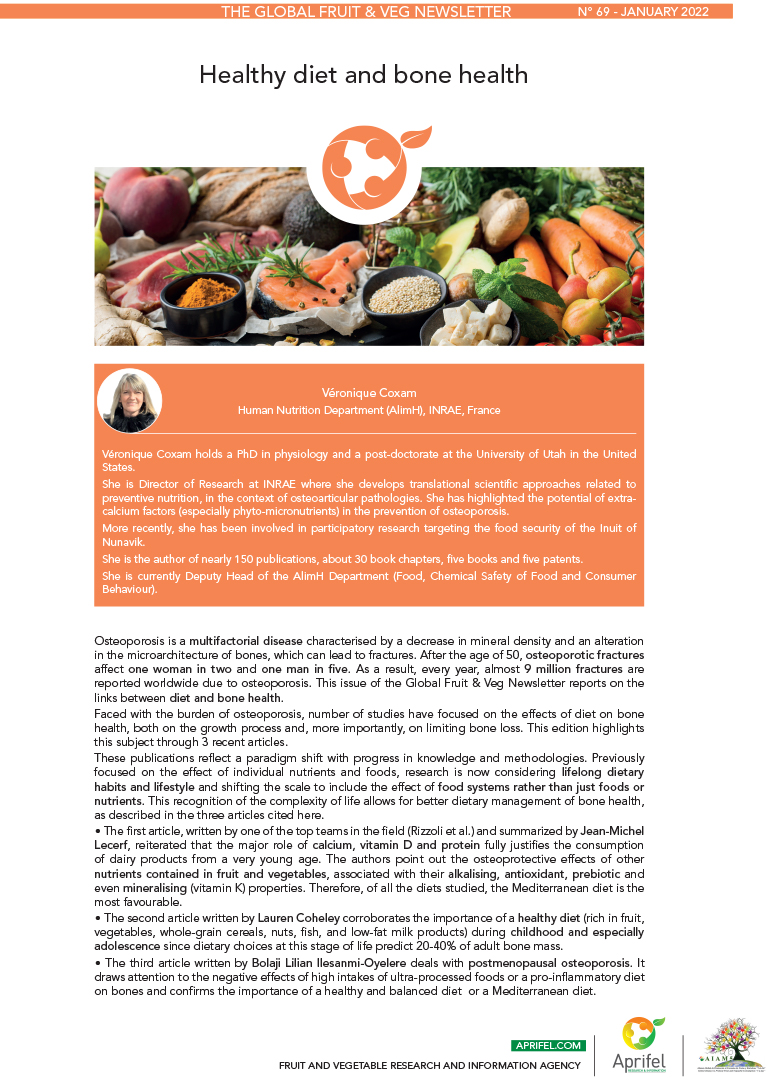Nutrient and dietary patterns to prevent postmenopausal osteoporosis

The aim of the present review was to report the current evidence and status of knowledge about the relationship between nutrient and dietary patterns and bone health in postmenopausal women.
Postmenopausal osteoporosis is characterized by an increased low-grade inflammation which contributes to low bone mass and degradation of bone mineral content resulting in bone loss and/or fractures (Brown, 2007; Brown, 2011). Osteoporosis is a multifactorial condition, but its key drivers include oestrogen deficiency, poor dietary habits, chronic inflammation, smoking, excessive alcohol consumption and sedentary lifestyle. Therefore, nutrition and lifestyle improvements could be essential to prevent osteoporosis (David, 2014). Several key nutrients, occuring together in foods and dietary in foods and dietary patterns, are known to affect bone mineral content and bone mineral density such as calcium and vitamin D, but also potassium, zinc magnesium, iron, copper, vitamin C and K found in fruit and vegetables.
Nutrient patterns and postmenopausal osteoporosis: heterogeneous results with no conclusive nutrient pattern
To date, only two studies have explored the relationship between nutrient patterns an bone health exclusively in postmenopausal women.
The first study (Karamati, 2014) showed that a dietary pattern associated with high in nutrients found mainly in fruit and vegetables (folate, fiber, vitamin B6, potassium, vitamin A, beta-caroten, magnesium, copper, and magnanese) was positively associated with lumbar spine bone mineral density. However, no significant correlation was found between well-known nutrients for their benefits for bone health in the pattern high in protein, calcium, phosphorus, zinc, vitamin B2, and vitamin B12 and low in vitamin E. This is mainly because the influence of protein intakes generally depends on a balanced whole diet in terms of acid-producing potential.
A positive association was found in the second study (Ilesanmi-Oyelere, 2019) between nutrient pattern characterized by high phosphorus, calcium, potassium, magnesium, vitamin B2, vitamin B6, carbohydrates, and sugars and lumbar spine, femoral neck, and whole-body bone mineral density. These nutrients are particularly found in eggs, lean meats, milk and milk products, and some fruit and vegetables. Meanwhile, nutrient pattern high in alpha and beta-carotene, vitamin E, and dietary fats was negatively associated with bone mineral density.
Dietary pattern analysis and score/index and bone health in postemenopausal osteoporosis
Due to interaction of various nutrient and foods, it is important to generate dietary pattern with correlated foods.
Some studies examined the association between traditionam Western diets charcterized by processed foods high in salts, fats, and sugars and bone health status. They evidenced a positive association with osteoporosis (Fairweather, 2011; Sugiura, 2011; Karamati, 2012; Chen, 2015; de França, 2016). In addition, the Dietary Inflammatory Index (DII) assessing diet’s inflammatory potential was inversely associated with bone mineral density, which indicates a relationship between inflammation and bone degeneration (Hamidi, 2011; Haring, 2016).
On the other hand, “healthy” and/or “prudent” dietary patterns including foods such as fruit, vegetables, milk, low-fat dairy, and nutrient dense foods have been associated wigh high bone mineral density. In general, the Mediterranean diet score that indicated compliance with Mediterranean diet , was directly associated with bone mineral density and inversely associated with fracture risk (Feart, 2013; Rivas, 2013).
Based on : Ilesanmi-Oyelere BL, Kruger MC. Nutrient and Dietary Patterns in Relation to the Pathogenesis of Postmenopausal Osteoporosis – A Literature Review. Life. 2020; 10(10):220.
- A “healthy” diet rich in fruit, vegetables and milk or a Mediterranean-style may be beneficial for bone health compared to Western dietary patterns.
- Policies to increase consumption of vegetables, fruits, whole grains, and low-fat milk is necessary for bone health from childhood to adulthood.

